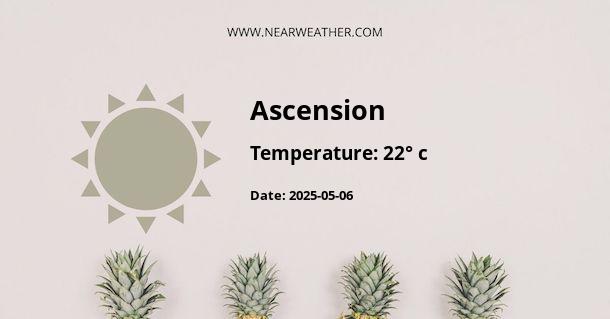The Climate and Weather in Ascension, Saint Helena
Ascension Island is a small volcanic island located in the South Atlantic Ocean, as part of the British Overseas Territory of Saint Helena. The island is known for its unique climate and diverse weather patterns that make it an interesting destination for travelers and weather enthusiasts. Let's explore the climate and weather conditions in Ascension throughout the year.
Geographical Location
Ascension Island is situated at a latitude of approximately 7.9 degrees south and a longitude of 14.4 degrees west. It is located about 1,600 kilometers (994 miles) northwest of Saint Helena and around 2,250 kilometers (1,398 miles) southeast of Brazil. The island is relatively small, covering an area of approximately 88 square kilometers (34 square miles).
Tropical Climate
Ascension Island has a tropical climate with relatively consistent temperatures throughout the year. The island primarily experiences two seasons: a dry season and a wet season. The dry season typically lasts from May to November, while the wet season occurs from December to April.
Temperature
The average annual temperature in Ascension Island ranges from 22 to 29 degrees Celsius (72 to 84 degrees Fahrenheit). The hottest months are January to March, with temperatures often reaching the high 20s or low 30s Celsius (80s to 90s Fahrenheit). The coolest months are July to September, with temperatures dropping to the low 20s Celsius (70s Fahrenheit).
Despite the warm temperatures, Ascension Island benefits from the cooling trade winds, which help to moderate the overall heat and provide a pleasant breeze.
Precipitation
Ascension Island receives most of its rainfall during the wet season, particularly in January and February. During this period, the island experiences occasional heavy showers and thunderstorms. The average annual precipitation ranges from 200 to 400 millimeters (8 to 16 inches), with some areas receiving slightly higher amounts due to local topography.
While the wet season brings increased rainfall, the island still experiences a relatively low amount of precipitation overall. This, combined with high evaporation rates, makes Ascension Island quite arid, with limited vegetation and water resources.
Weather Patterns
Due to its location in the South Atlantic Ocean, Ascension Island is subject to various weather patterns that can influence its climate. These include the South Atlantic High pressure system, trade winds, and the Inter-Tropical Convergence Zone (ITCZ).
The South Atlantic High pressure system, also known as the Saint Helena High, is a semi-permanent high-pressure area that influences the weather in the region. It brings stable conditions and generally good weather to Ascension Island, with clear skies and moderate winds.
The trade winds, blowing from the southeast, are another significant weather feature of Ascension Island. These winds help to cool the island and provide a refreshing breeze, making it a pleasant place to visit even during the hottest months.
The Inter-Tropical Convergence Zone (ITCZ) is a belt of low pressure that moves north and south of the equator, bringing periods of increased rainfall to Ascension Island during the wet season. The ITCZ can cause more frequent and intense thunderstorms and showers, but they are generally short-lived.
Climate Charts
Let's take a closer look at the climate data for Ascension Island using charts that illustrate the average monthly temperatures and rainfall throughout the year.
Temperature Chart
| Month | Average Temperature (°C) |
|---|---|
| January | 27 |
| February | 28 |
| March | 28 |
| April | 28 |
| May | 26 |
| June | 24 |
| July | 23 |
| August | 23 |
| September | 24 |
| October | 25 |
| November | 26 |
| December | 27 |
The temperature chart shows relatively stable temperatures throughout the year, with January, February, and March being the warmest months. July and August are the coolest months, but the temperature remains mild.
Rainfall Chart
| Month | Average Rainfall (mm) |
|---|---|
| January | 58 |
| February | 86 |
| March | 74 |
| April | 43 |
| May | 15 |
| June | 4 |
| July | 2 |
| August | 1 |
| September | 4 |
| October | 11 |
| November | 23 |
| December | 47 |
The rainfall chart illustrates the wet and dry seasons on Ascension Island. January and February are the rainiest months, while June, July, and August receive the least amount of rainfall. The dry season is characterized by significantly lower precipitation levels.
Conclusion
Ascension Island, located in the South Atlantic Ocean, has a tropical climate with relatively consistent temperatures throughout the year. The island experiences a dry season from May to November and a wet season from December to April. Trade winds and the South Atlantic High pressure system contribute to the pleasant weather conditions on the island, while the Inter-Tropical Convergence Zone brings increased rainfall during the wet season.
Travelers to Ascension Island can expect warm temperatures, cooling trade winds, occasional showers, and limited vegetation due to the arid climate. Whether you are interested in exploring its unique volcanic landscapes or observing its diverse wildlife, Ascension Island offers a fascinating destination for those interested in both weather and natural beauty.
A - Ascension's Latitude is -7.950000 & Longitude is -14.350000.
A - Weather in Ascension is 22° today.
A - Climate Conditions in Ascension shows broken clouds today.
A - Humidity in Ascension is 75% today.
A - Wind speed in Ascension is 22.25 km/h, flowing at 117° wind direction. today.
